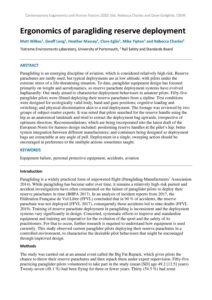| Document | Author Matt Wilkes, Geoff Long, Heather Massey, Clare Eglin, Mike Tipton and Rebecca Charles |
| Abstract Paragliding is an emerging discipline of aviation, which is considered relatively high risk. Reserve parachutes are rarely used, but typical deployments are at low altitude, with pilots under the extreme stress of a life-threatening situation. To date, paraglider equipment design has focused primarily on weight and aerodynamics, so reserve parachute deployment systems have evolved haphazardly. Our study aimed to characterise deployment behaviours in amateur pilots. Fifty-five paraglider pilots were filmed deploying their reserve parachutes from a zipline. Test conditions were designed for ecologically valid body, hand and gaze positions; cognitive loading and switching; and physical disorientation akin to a real deployment. The footage was reviewed by two groups of subject matter experts. It was noted that pilots searched for the reserve handle using the hip as an anatomical landmark and tried to extract the deployment bag upwards, irrespective of optimum direction. Recommendations, which are being incorporated into the latest draft of the European Norm for harness design included: positioning reserve handles at the pilot’s hip; better system integration between different manufacturers; and containers being designed so deployment bags are extractable at any angle of pull. Deployment in a single, sweeping action should be encouraged in preference to the multiple actions sometimes taught. |

